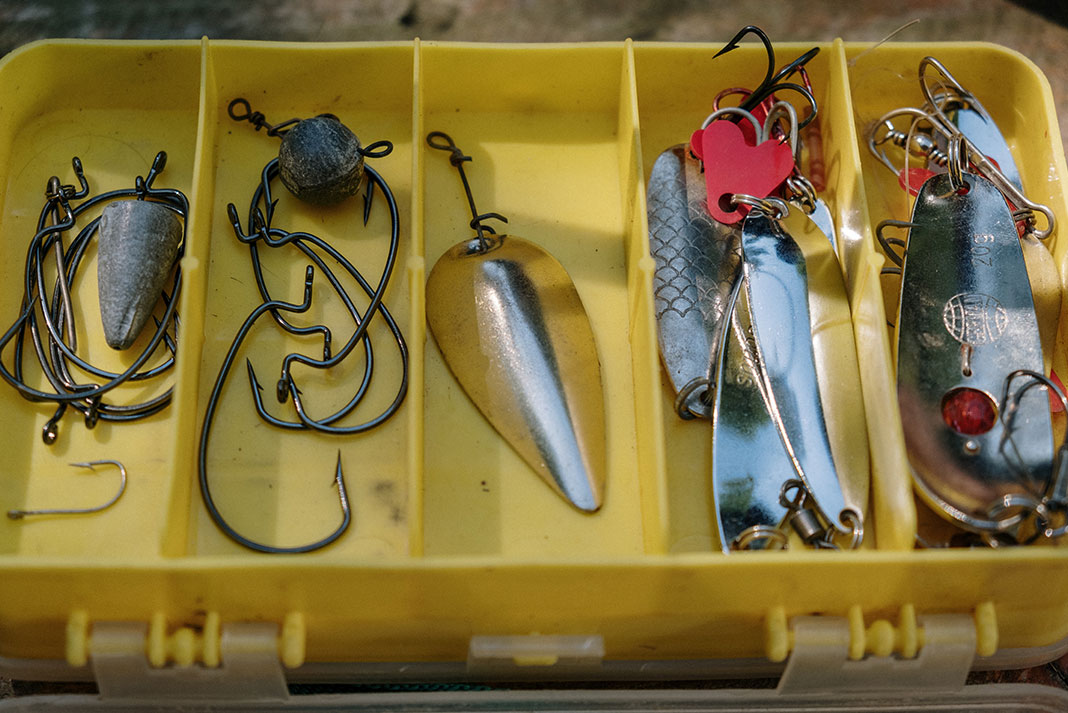
There are many fishing hook types. From tiny flea-size No. 32 to palm-sized 27/0, there is a fishing hook for every application. To match a fishing hook to the purpose, consider the size of the bait you will use. Then, estimate the size of the fish you will target. And how does the fish behave?
While there are thousands of hooks, you can narrow the choice by following some simple tips. This fishing hook guide will give you a few pointers for picking the right hook.
VIEW ALL KAYAK FISHING GEAR SHOP FISHING HOOKS ON AMAZON
[This article is part of the Kayak Angler Buyer’s Guide for The Best Kayak Fishing Gear For 2024. Find all the best kayak fishing gear from the top brands for all situations.]
Fishing Hook Parts
The hook shank goes from the eye to the bend. The size of the hook is measured from the shank to the hook point, called the gap. The hook point has a barb to keep it from backing out of the fish. Barbless hooks are safer for the fish and the angler.
On an offset hook, the hook point is slightly out of alignment with the shank, improving the chances of hooking the fish. Even though all hooks share the same parts, there are many variations to create the best hook for a specific type of fishing.
Fishing Hook Types
J-hook
The most common type of hook is a J-hook. The point of a J-hook is parallel to the shank to form the letter “J.” There are dozens of J-hooks, each with features that make it perfect for a specific type of fishing.
For example, baitholder hooks have barbs on the shank to hold a piece of bait. Aberdeen hooks have a long shank to make it easier to unhook the fish. Kahle hooks have a wide bend that works best with a strip bait. Live bait hooks use a short shank to allow the bait to swim freely.
Anglers fishing lightweight soft plastics use a worm hook with a wide gap and bent eye to hide the barb in the worm. And that’s just a few of the many types of J-hooks.
Circle Hook
The circle hook is one of the biggest advancements in fish conservation. Proven to save fish lives, some fisheries mandate circle hook use. Like the name says, the hook point circles over and points at the shank. When a fish bites a circle hook, tension on the line pulls the hook through the fish’s mouth and around its jaw. This action avoids deep-hooking a fish, one of the leading causes of post-release mortality.
Circle hooks work best with natural bait. It’s best to bridle the bait to a circle hook. When the fish bites, apply steady pressure to the line and the hook will find its way into the corner of the fish’s mouth. No need to haul back on the rod, the circle hook does the work.
Treble Hook
Some fish strike so violently, the only hope of hooking them is with a treble hook. Treble hooks have three hook points on one shank to snag the fish when it attacks. Treble hooks are used on artificial lures to catch the fish before it spits the bait. Live bait anglers often use treble hooks to snare a violent fish. Always use pliers to remove a treble hook from the fish.
Fishing Hook Sizes
Fish hooks are measured in sizes from No. 32 to 27/0. Small hooks are measured with No. (number). The numbers descend as the hook size grows. The smallest hook, No. 32, is the size of an ant while a No. 1 hook is as big as a bumblebee.
Large hooks are measured in 1/0 (pronounced one-aught) to a huge 27/0 hook. A 1/0 hook will fit on top your fingernail while a 27/0 takes up your whole hand. Stronger hooks are marked with a 1X to 4X to indicate heavier wire.
What Size Fishing Hook to Use
Choose a fish hook that matches the size of your bait and the fish you plan to target. To improve the action of a lure or bait, use the smallest hook possible. The hook should never be larger than the bait. Fly fishermen use tiny No. 32 hooks to tie small bug patterns. Shark fishermen use a huge 22/0 hook to hold a five-pound chunk of bait. Anglers targeting panfish use a hook with a small gap to fit in the fish’s small mouth. The shark fishermen rely on a huge hook to survive powerful jaws and teeth.
How to Use a Fishing Hook
When putting cut bait on a hook, pass the hook through the bait one time. Gobbing the bait onto the hook will affect the hook’s performance. Live bait should also be hooked lightly to allow it to swim naturally.
To thread a soft plastic lure onto a jig, first measure the hook against the soft plastic and note where the hook will exit the plastic. Then, thread the plastic onto the hook and push the tip out of the point you measured earlier. The soft plastic should be straight and even on the hook. Use a dab of super glue to hold the plastic to the hook. A hook works best when its bend and point are exposed.
Choose a fishing hook that matches the size of your bait and the type of fish you plan to target. | Feature photo: Cottonbro/Pexels